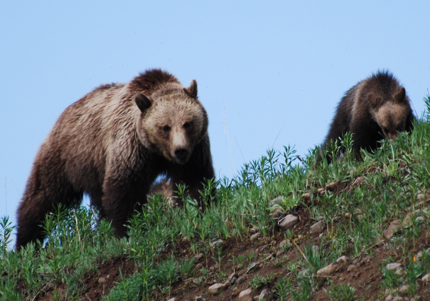 Grizzly bear and cub near Mt. Washburn, Yellowstone National Park. Photo: Beth Pratt
Grizzly bear and cub near Mt. Washburn, Yellowstone National Park. Photo: Beth Pratt
In Yellowstone this year, bears have received much attention, from the grizzly sow that gave birth to a rare four cubs, to the recent attacks outside the park. I spoke this week with Kerry Gunther, National Park Service Bear Management Biologist in Yellowstone, for an ursine update.
How are the bears overall in Yellowstone doing?
We had good cub production in the park this year and cub production significantly exceeded human-caused bear mortality, so bears in Yellowstone National Park have been doing fairly well so far this year.
One of the highlights this year for park visitors has been viewing the grizzly sow that gave birth to a rare four cubs. How are the bear and her four cubs doing? Are all the cubs still alive?
The female with the four cubs was observed earlier this week. She and all four cubs are doing well so far.
What is the likelihood that all four bear cubs will survive?
The probability of a grizzly bear cub surviving its first year is about sixty-four percent. Very few bears die during hibernation, so if they make it to denning they have a high chance of surviving to their yearling year. They have beaten the odds so far.
At least anecdotally, this appears to be a great year for bear sightings in the park. Statistically has there been an actual increase in activity? If so, any reason for the increased bear sightings?
So far, we have not really had significantly more bear sightings than last year. Because whitebark pine trees did not produce many cones this year, we expect to have more late summer and fall sightings than last year because bears will likely be down at lower elevations eating roots and other foods. Last year the whitebark pine seed production was very good and so bears were up high in the forest during late summer and fall and thus less visible.
There have been many reports on the relationship between grizzly bears and the whitebark pine decline, most citing that the demise of the tree will have pretty significant consequences for the bears. Do you agree?
Bears are very adaptable, omnivore generalists that are capable of diet switching. They have adapted to the loss of whitebark pine in other ecosystems. In some years, the whitebark pine trees in the GYE don’t produce many cones, and bears have switched to other fall foods those years. We don't know exactly how the complete loss of whitebark pine may affect bears. Tree mortality appears to be lower this year. So hopefully the worst of the mountain pine beetle mortality of whitebark pine is now behind us.
There have been two bear attacks in the Greater Yellowstone Area recently (although none in the park). Is this unusual? Do you think the bears are especially stressed this year?
Nutritional stress may have been a contributing factor in the bear attacks at the Soda Butte Campground outside of Cooke City. The attack in the Kitty Creek drainage on the Shoshone National Forest was not likely related to food stress in any way.
Do you have any ideas what caused the recent attack at Soda Butte? Wildlife officials have said this isn't typical bear behavior.
We have no way of knowing for sure why the bear attacked the campers at the Soda Butte Campground. Bears are predators and although it’s extremely rare, they do sometimes prey on people.
View a slide show of some of my bear sightings in the park this year below:

